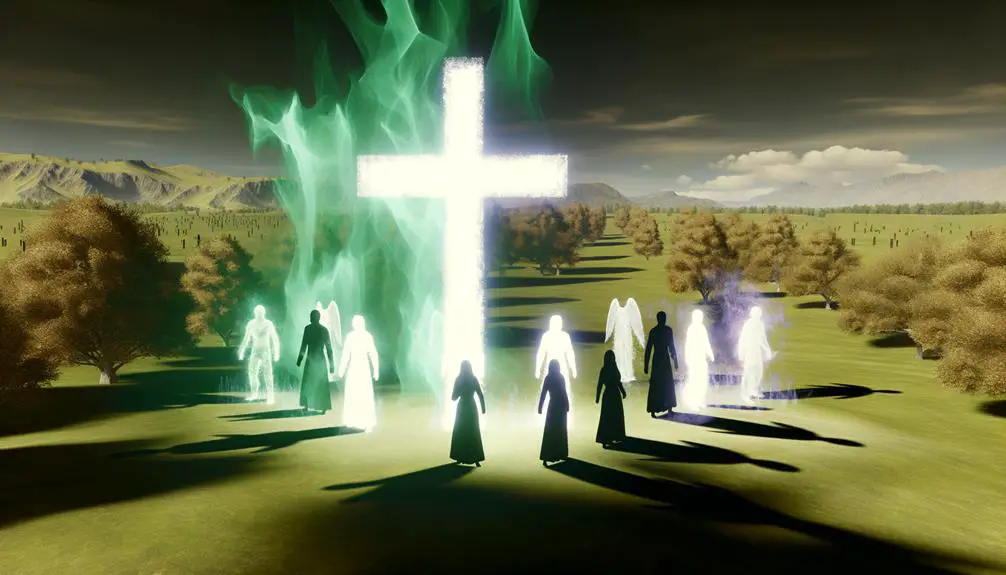In the Bible, deliverance embodies God's powerful interventions, from Exodus to Christ's resurrection—discover how this shapes faith and freedom.

Deliverance Meaning in the Bible
In the Bible, deliverance principally signifies God's act of rescuing you from sin, oppression, or danger. This theme is deeply embedded in the theology of redemption, involving multifaceted divine interventions. Historically, notable narratives like the Exodus illustrate how deliverance shifts individuals and groups from suffering to freedom through divine action. In the New Scripture, Jesus' life, death, and resurrection are portrayed as the ultimate fulfillment of deliverance promises. The concept is further explored in Psalms and Prophetic literature, which emphasize divine rescue and protection. Understanding this broad and essential theme offers deeper insights into the spiritual dynamics emphasized throughout the scriptures.
Key Takeaways
- Deliverance in the Bible refers to God's act of rescuing people from sin, oppression, or danger.
- It often involves divine intervention and is linked closely with the theme of redemption.
- Biblical stories like the Exodus and Daniel in the Lion's Den illustrate God's power to save and protect.
- In the New Testament, Jesus' life, death, and resurrection are seen as the ultimate fulfillment of God's deliverance.
- Psalms and prophetic books frequently explore and celebrate the theme of divine rescue and protection.
Definition of Biblical Deliverance

In biblical terms, deliverance refers to the act whereby God rescues individuals from sin, oppression, or danger through divine intervention. This concept is central to deliverance theology, which interprets these acts not merely as historical events but as ongoing spiritual realities. You'll find that deliverance is deeply intertwined with the idea of redemption, both representing God's saving actions.
Deliverance theology posits that the divine intervention in deliverance is not random but follows a divine logic that mirrors the broader narrative of redemption found throughout the Bible. The parallels between deliverance and redemption are significant because they both involve a shift from a state of suffering or bondage to one of freedom and safety, orchestrated by divine action. For instance, the Exodus story, where God delivers the Israelites from Egyptian bondage, parallels the redemptive act of Christ saving humanity from sin.
These narratives underscore a fundamental belief in the power and willingness of God to intervene in the lives of the faithful in a transformative manner. As you explore deeper, you'll recognize that the themes of deliverance and redemption are not only about physical or historical rescue but also about spiritual salvation and renewal. Understanding this helps you appreciate the multifaceted nature of God's interventions as depicted in biblical scripture.
Historical Instances of Deliverance
You'll notice that Biblical narratives often highlight themes of deliverance as pivotal moments of faith and divine intervention. The Exodus from Egypt exemplifies this, where the Israelites' liberation from slavery is portrayed not just as a historical event, but as a theological revelation of God's power and mercy. Similarly, the story of Daniel in the Lion's Den serves to underscore the protection and vindication God provides to those who remain faithful under persecution.
Exodus From Egypt
The Exodus from Egypt represents a pivotal instance of divine deliverance in biblical history. Under Moses' leadership, the Israelites sought liberation from the oppressive Egyptian regime. This narrative is marked by a series of confrontations where Pharaoh's resistance to the Israelites' emancipation plays a central role. Moses, as a divinely appointed leader, confronts Pharaoh with demands for his people's freedom, underscored by miraculous signs and plagues as direct interventions from God. This struggle not only highlights the tyrannical obstinacy of Pharaoh but also sets the stage for a profound demonstration of divine power and justice. Through this deliverance, you're invited to reflect on the themes of liberation, faith, and divine intervention that resonate throughout the biblical text.
Daniel in Lions' Den
Daniel's ordeal in the lions' den exemplifies another profound instance of divine deliverance, vividly illustrating the protective power wielded by faith in God. Lion symbolism in this narrative is potent, representing not only mortal danger but also majestic power, suggesting that even the most formidable threats are under divine command. The angelic intervention that occurs, where an angel shuts the lions' mouths, underscores a celestial guardianship aligned with the faithful. This episode serves as a confirmation to the belief that divine forces intervene directly to rescue the devout from peril. Analyzing this, you're reminded that deliverance isn't merely about physical survival but profoundly about the affirmation of faith amid dire circumstances.
Deliverance in Psalms and Prophecy

Deliverance in the Psalms and prophecy often symbolizes God's intervention to save His people from peril. You'll find that the Psalms, a collection of lyrical poems, are replete with themes of divine rescue and protection. These texts not only express the fears and hopes of their composers but also serve as profound vehicles for understanding the broader concept of prophetic redemption within the biblical narrative.
When you explore Psalms interpretation, it's important to recognize how these ancient songs frequently anticipate or reflect prophetic themes. For instance, Psalm 18 vividly depicts a God who is a deliverer and a fortress, rescuing the psalmist from enemies. This portrayal aligns closely with prophetic descriptions of God's future acts of salvation for Israel, highlighting a thematic continuity between personal and communal deliverance.
Furthermore, the prophetic literature in the Bible enhances and expands on the deliverance themes found in the Psalms. Prophets like Isaiah and Jeremiah speak of a time when God will bring ultimate redemption to His people—a future where suffering and oppression are no more. This prophetic vision complements the immediate and personal deliverance described in the Psalms, offering you a layered understanding of God's saving grace that spans from the personal to the eschatological.
Jesus and New Testament Deliverance
Moving from the Old Covenant, you'll find that in the New Agreement, Jesus embodies and fulfills these themes of deliverance. His approach, deeply rooted in parable teachings, offers both immediate and eschatological insights into deliverance. Jesus' parables, such as the Prodigal Son and the Good Samaritan, illustrate the themes of redemption and forgiveness, signaling a deliverance that transcends physical liberation, emphasizing a more profound, spiritual rescue.
The resurrection of Jesus marks a pivotal point in the New Scripture, highlighting the resurrection significance as the ultimate act of divine deliverance. It not only confirms Jesus' deity but also assures believers of their own future resurrection and eternal deliverance from sin and death.
Here's a structured view to help you visualize the New Deliverance themes:
Aspect |
Description |
Significance |
|---|---|---|
Parable Teachings |
Use everyday scenarios to reveal spiritual truths |
Illustrate the process and possibility of spiritual deliverance |
Miracles |
Acts of healing and power |
Demonstrate authority over physical and spiritual domains |
Crucifixion |
Sacrificial death |
Initiates the new agreement of deliverance from sin |
Resurrection |
Defeat of death |
Guarantees eternal deliverance |
Ascension |
Jesus' return to Heaven |
Paves the way for the Holy Spirit's role in ongoing deliverance |
Through these acts and teachings, Jesus not only continues the biblical narrative of deliverance but expands it, offering a new dimension where spiritual salvation is foregrounded.
Spiritual Warfare and Deliverance

In the domain of biblical teachings, spiritual warfare represents an essential component of the believer's journey toward deliverance. You are engaged in a constant battle against spiritual forces that seek to undermine your spiritual authority and obstruct your path to freedom. This confrontation is not merely symbolic but involves active engagement through prayer, faith, and the wielding of spiritual truths.
Deliverance rituals are integral to this process. They empower you to reclaim authority over demonic influences and disturbances in your life. These rituals, deeply rooted in scriptural principles, involve specific prayers and actions aimed at severing the ties that bind you to spiritual oppression. By invoking the name of Jesus and employing the authority granted to you as a believer, you activate the power inherent in your faith.
Understanding your spiritual authority is vital. It's not an abstract concept but a tangible asset you possess. This authority comes from Christ himself, who overcame the powers of darkness and delegated that victory to you. Hence, when you engage in spiritual warfare, you're not merely reciting words; you're exercising a power that has been judicially granted to you to effectuate deliverance and establish God's will in your life, as reflected in the Scriptures.
Personal Testimonies of Deliverance
You'll find that personal testimonies of deliverance within biblical narratives often highlight miraculous escapes, exemplify profound spiritual transformations, and showcase healing through unwavering faith. These accounts provide not only cultural and theological insights but also serve as empirical evidence supporting the power of divine intervention. By examining these stories, you can discern patterns and principles applicable to contemporary spiritual practices and beliefs.
Miraculous Escape Stories
Exploring personal testimonies of deliverance, these stories often recount moments of miraculous escape that defy conventional explanations. Consider Paul's shipwreck, as narrated in the Acts of the Apostles. Despite the ferocity of the storm and the ship breaking apart, Paul and all aboard were saved, underscoring a divine orchestration beyond mere luck or coincidence. Similarly, Peter's release from prison, facilitated by an angelic visitation, highlights not just an escape from physical chains but a demonstration of the power of faith and divine intervention. These narratives aren't just historical accounts; they serve as profound illustrations of faith's role in overcoming seemingly insurmountable obstacles. They invite you to reflect on the broader implications of divine deliverance in your own life.
Spiritual Transformation Examples
While miraculous escapes highlight divine intervention, personal testimonies of spiritual transformation reveal how individuals' lives are profoundly reshaped through experiences of deliverance. These narratives often emphasize inner renewal, a profound reorientation of one's heart and mind toward spiritual truths. The process is typically marked by transformative repentance, where you don't just turn away from old behaviors but are drawn into a deeper, more authentic relationship with the divine.
This shift isn't merely behavioral; it's foundational, affecting every aspect of your existence. You'll find that such transformation is not a momentary change but a continuous unfolding, where each step forward reinforces a commitment to live in alignment with higher spiritual principles. This journey of renewal is both personal and universal, reflecting a powerful indication of the transformative potential of divine deliverance.
Healing Through Faith
Personal testimonies of deliverance often reveal how deeply individuals' faith facilitates their emotional and spiritual healing. These narratives underscore the profound impact that faith manifestations can have on one's life, particularly in moments of profound despair. Analyzing various healing testimonies, it's apparent that faith not only sustains but also transforms individuals, offering a pathway to recovery that is deeply intertwined with spiritual renewal.
Emotional State Before |
Emotional State After |
|---|---|
Despair |
Hope |
Anxiety |
Peace |
Isolation |
Community |
Fear |
Courage |
Sickness |
Health |
Each transformation highlights a journey from a place of suffering to a state of grace, facilitated by a resilient, unwavering faith in a higher power.
Role of Faith in Deliverance
In biblical narratives, faith is often depicted as a critical catalyst for deliverance, emphasizing its integral role in the liberation of individuals or groups. The dynamics of faith reveal that trust in a higher power isn't merely passive; it's an active engagement with the divine. This trust has profound implications, shaping how deliverance is perceived and experienced.
- Faith as a Shield: Faith acts as a protective barrier, shielding believers from despair and hopelessness, fortifying their spirits against trials.
- Faith as a Connector: It bridges the gap between human incapacity and divine power, facilitating a transformative interaction that underpins deliverance.
- Faith as a Testimony: The exercise of faith in the face of adversity becomes a powerful testimony to others, demonstrating the possibility and reality of divine intervention.
You'll find that faith isn't just about believing in something unseen; it involves a deep, personal trust that influences outcomes. This trust fosters a resilience that is central to the narrative of deliverance in the scriptures. By understanding these elements, you can appreciate how faith operates not only as a spiritual dynamic but also as a practical tool in the lives of those seeking liberation.
Prayers for Spiritual Deliverance

Prayers for spiritual deliverance are fundamental tools utilized by believers to seek liberation from spiritual bondage. These prayers, often deeply embedded in deliverance rituals, serve not only as personal supplications but also involve the community through intercessory roles. As you explore these practices, you'll notice that the act of deliverance is both a personal and collective endeavor, where the afflicted individual and the community engage in a spiritual warfare against demonic influences.
The structure of these prayers is meticulously designed to affirm the sovereignty of God over all evil. By invoking divine authority, you're fundamentally participating in a ritualistic exercise that reinforces the power dynamics between the spiritual and the earthly domains. This aspect is vital because it highlights the belief in a higher power's ability to intervene and rectify instances of spiritual malaise.
Moreover, the intercessory role in deliverance rituals underscores the communal aspect of spiritual warfare. When others intercede on your behalf, they are actively inserting themselves into a spiritual struggle, embodying the biblical mandate to bear one another's burdens. This collective participation not only amplifies the spiritual force of the prayer but also fortifies the communal bonds through shared spiritual goals.
Modern Applications of Deliverance
Adapting ancient rituals of deliverance to contemporary settings, believers today utilize these practices to address modern spiritual challenges. This integration, often termed ‘Deliverance therapy,' exemplifies a profound case of cultural adaptation, where historical spiritual methodologies are recalibrated for today's societal norms and psychological understandings. You, as a modern believer or a curious observer, might find deliverance therapy intriguing as it melds spiritual liberation with psychological insights, offering a multifaceted approach to personal healing.
Key aspects of this modern application include:
- Contextualization: Adapting deliverance practices to fit the cultural and societal context of the practitioner and recipient, ensuring relevancy and resonance with contemporary issues.
- Integration with Mental Health Practices: Collaborating with psychological theories and practices to form a holistic treatment model that addresses both spiritual and mental health.
- Personalized Rituals: Developing unique deliverance rituals that cater to the individual's specific spiritual and emotional needs, rather than applying a one-size-fits-all approach.
Through these adaptations, deliverance therapy serves not only as a bridge between ancient faith-based practices and modern therapeutic techniques but also as a reflection of the enduring human quest for spiritual and psychological well-being.
Frequently Asked Questions
How Do Different Christian Denominations Interpret Deliverance?
Different Christian denominations interpret deliverance through varied denominational practices and scriptural interpretations. You'll find that these differences stem from distinct theological frameworks and historical contexts influencing each denomination's approach to understanding deliverance.
Are There Any Deliverance Rituals Specific to Eastern Orthodox Christianity?
Yes, in Eastern Orthodox Christianity, you'll find specific deliverance rituals, including Orthodox exorcisms and prayer rituals, meticulously structured to address spiritual afflictions and provide protection through the intercession of saints and the Holy Scripture.
What Role Do Angels Play in the Concept of Deliverance?
In discussions of angelic interventions, angels are often seen as messengers and protectors. Their guardian roles in deliverance signify a bridge between divine will and human experience, ensuring spiritual safety and guidance.
How Do Non-Christian Religions View the Concept of Deliverance?
In non-Christian religions, you'll find varied interpretations of deliverance. Hinduism discusses Moksha, liberation from the cycle of rebirth, while Islam focuses on salvation through submission to God's will and good deeds.
Can Deliverance Be Considered a Psychological Phenomenon?
Imagine a mind tangled in shadows, where deliverance acts as a beam of light. It's akin to emotional healing and cognitive restructuring, deeply analyzed as a psychological phenomenon impacting mental states and behaviors.



Sign up